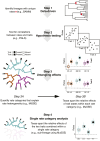Opportunity begets opportunity to drive macroevolutionary dynamics of a diverse lizard radiation
- PMID: 39328284
- PMCID: PMC11424082
- DOI: 10.1093/evlett/qrae022
Opportunity begets opportunity to drive macroevolutionary dynamics of a diverse lizard radiation
Abstract
Evolution proceeds unevenly across the tree of life, with some lineages accumulating diversity more rapidly than others. Explaining this disparity is challenging as similar evolutionary triggers often do not result in analogous shifts across the tree, and similar shifts may reflect different evolutionary triggers. We used a combination of approaches to directly consider such context-dependency and untangle the complex network of processes that shape macroevolutionary dynamics, focusing on Pleurodonta, a diverse radiation of lizards. Our approach shows that some lineage-wide signatures are lost when conditioned on sublineages: while viviparity appears to accelerate diversification, its effect size is overestimated by its association with the Andean mountains. Conversely, some signals that erode at broader phylogenetic scales emerge at shallower ones. Mountains, in general, do not affect speciation rates; rather, the occurrence in the Andean mountains specifically promotes diversification. Likewise, the evolution of larger sizes catalyzes diversification rates, but only within certain ecological and geographical settings. We caution that conventional methods of fitting models to entire trees may mistakenly assign diversification heterogeneity to specific factors despite evidence against their plausibility. Our study takes a significant stride toward disentangling confounding factors and identifying plausible sources of ecological opportunities in the diversification of large evolutionary radiations.
Keywords: Andes; body size; diversification; reptiles; viviparity.
© The Author(s) 2024. Published by Oxford University Press on behalf of The Society for the Study of Evolution (SSE) and European Society for Evolutionary Biology (ESEN).
Figures





Similar articles
-
What defines an adaptive radiation? Macroevolutionary diversification dynamics of an exceptionally species-rich continental lizard radiation.BMC Evol Biol. 2015 Aug 7;15:153. doi: 10.1186/s12862-015-0435-9. BMC Evol Biol. 2015. PMID: 26245280 Free PMC article.
-
The Sequential Direct and Indirect Effects of Mountain Uplift, Climatic Niche, and Floral Trait Evolution on Diversification Dynamics in an Andean Plant Clade.Syst Biol. 2024 Sep 5;73(3):594-612. doi: 10.1093/sysbio/syae011. Syst Biol. 2024. PMID: 38554255 Free PMC article.
-
Macroevolutionary diversification with limited niche disparity in a species-rich lineage of cold-climate lizards.BMC Evol Biol. 2018 Feb 6;18(1):16. doi: 10.1186/s12862-018-1133-1. BMC Evol Biol. 2018. PMID: 29409440 Free PMC article.
-
Diversification in evolutionary arenas-Assessment and synthesis.Ecol Evol. 2020 May 19;10(12):6163-6182. doi: 10.1002/ece3.6313. eCollection 2020 Jun. Ecol Evol. 2020. PMID: 32607221 Free PMC article. Review.
-
Phylogenetic tests for evolutionary innovation: the problematic link between key innovations and exceptional diversification.Philos Trans R Soc Lond B Biol Sci. 2017 Dec 5;372(1735):20160417. doi: 10.1098/rstb.2016.0417. Philos Trans R Soc Lond B Biol Sci. 2017. PMID: 29061890 Free PMC article. Review.
References
-
- Alfaro, M. E., Faircloth, B. C., Harrington, R. C., Sorenson, L., Friedman, M., Thacker, C. E., & Near, T. J. (2018). Explosive diversification of marine fishes at the Cretaceous-Palaeogene boundary. Nature Ecology and Evolution, 2, 688–696. - PubMed
-
- Alfaro, M. E., Santini, F., Brock, C., Alamillo, H., Dornburg, A., Rabosky, D. L., Carnevale, G., & Harmon, L. J. (2009). Nine exceptional radiations plus high turnover explain species diversity in jawed vertebrates. Proceedings of the National Academy of Sciences of the United States of America, 106(32), 13410–13414. 10.1073/pnas.0811087106 - DOI - PMC - PubMed
-
- Atkinson, D. (1994). Temperature and organism size: A biological law for ectotherms? Advances in Ecological Research, 25, 1–58.
LinkOut - more resources
Full Text Sources


